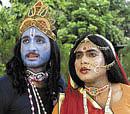
Using metaphors and the pastoral landscape of rural West Bengal, Das creates a world that is very real, where simple, gullible commoners become pawns at the hands of ruthless politicians. Eerily, the film resembles to a great extent the cruel world of grassroots politics in West Bengal and elsewhere of recent times, where villagers owing allegiance to one party can kill or maim co-villagers just because they support another party, more often than not their acts remote-controlled by local political-mafia nexus who exploit their belief in ideologies which the power-hungry leaders themselves seldom follow.
Starting from the title itself, Das uses a number of metaphors in his film to tell his story. The story moves forward on two parallel tracks that get combined as the film progresses, with the metaphor of ‘Bohurupis’, or the traditional travelling performers of mythological dance dramas who wear a mask to become the mythical characters but are forced to wear identities other than their own in real life too, used liberally. In fact, it is the invisible masks that people wear quite often that forms the basis of character graph development in the film.
Based on a short story titled ‘Du Nombor Ashami’ (Accused No:2), Kaler Rakhal is about Subol Mondol (Parambrata Chatterjee), who by heart is a ‘Bohurupi’, but is forced to become a pawn at the hands of the politician-mafia nexus, which forces him often to wear the ‘mask’ of a culprit whom the local corrupt police puts behind the bars every time various political crimes are committed at the local level.
Subol Mandal’s story moves parallel to the story of a young NRI woman, who comes from Germany to do a television programme on the Bohurupi culture but gets entangled in the developing unrest, becoming a victim of sexual violence at the hands of the local ruffians who double up as the henchmen of the political class. Her story moves along with the story of another woman, whose husband, an ideological politician, was bumped off by his corrupt political colleague, with whom she is forced to have a relationship so that she can lead a life of presumed safety.
A number of other characters people the film, all representing various facets of exploitation of the poorest, such as a poor Bohurupi exponent who is forced to sell his wife’s body to a local politician just to be able to earn his next meal, the symbolic — though a bit predictable — character of a man who has gone mad because his orchard got “stolen” by the government during the widening of a road, and the old, cultured gentleman (played by thespian Soumitra Chatterjee) who critiques the system but himself is incapable of offering any solace to his young NRI relative who gets raped.
The film’s strong points lie in its strong political undertone and the equally evocative depiction of the cultural milieu that is fighting to keep afloat in the face of the onslaught of modern day ‘entertainment’ which is slowly but surely polluting traditional cultures that are intrinsically linked to the rural society irrespective of religious, caste or community identities. While the political undercurrent of the subject gives a required edgy feel to the film, the cultural aspect is used by the director to use folk music elements that counters this to create a thematic variety, though the number of songs, like the theatrical depiction of the way the local hoodlums, tend to derail the overall pace of the film at certain places.
The film’s soul is the character of Subol, who, to earn some extra money that can assure proper meals to his family, often plays the role of an accused who goes behind the bars for the crimes committed by local lumpen elements who are the henchmen of the political class. In a sense, Subol represents all those innocent people who unwittingly are forced to become a part of the vicious political system which requires such people to die in demonstrations, to commit self-immolations in protest against something or the other, or to simply shout slogans at rallies, more often than not because that will earn them some money that will assure them a few days of proper livelihood.
For Das, whose previous two films Mahulbanir Sereng and Krantikaal were also on class exploitation, Kaler Rakhal completes a trilogy on the same theme. With a cast that comprises Nandana Sen in her first appearance in a Bengali film, Kaler Rakhal makes for compelling viewing. And Das is happy that he has achieved to a great extent what he had set out to do. “I had this story with me, written by Swapan Bandopadhyay, 2005 onwards, and as days progressed, I became convinced that it could be a really great story to tell,” says Das.
Das feels that it is pointless doing a film unless it reflects the times we are in. “I always debate with my friends that we can otherwise do just aesthetic exercises. I tour villages though I am an urbanite, and those images attract me more than my very close set-up.”